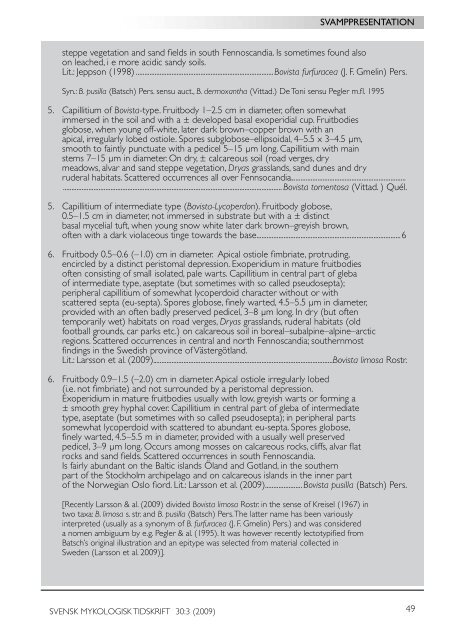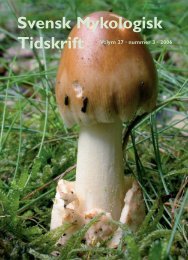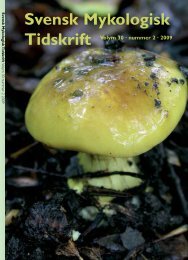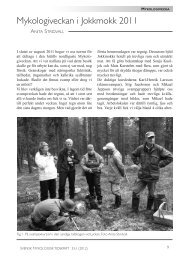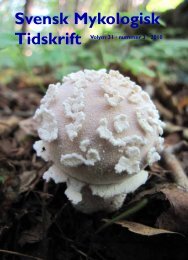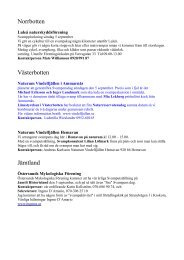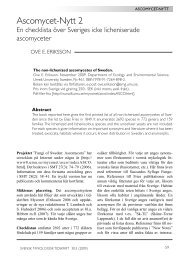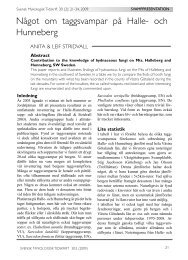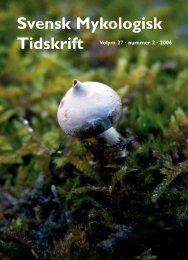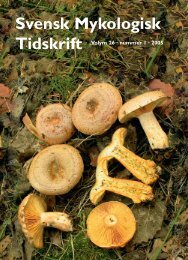SMT 3-2009 - Sveriges Mykologiska Förening
SMT 3-2009 - Sveriges Mykologiska Förening
SMT 3-2009 - Sveriges Mykologiska Förening
- No tags were found...
Create successful ePaper yourself
Turn your PDF publications into a flip-book with our unique Google optimized e-Paper software.
SVAMPPRESENTATIONsteppe vegetation and sand fields in south Fennoscandia. Is sometimes found alsoon leached, i e more acidic sandy soils.Lit.: Jeppson (1998) .................................................................................Bovista furfuracea (J. F. Gmelin) Pers.Syn.: B. pusilla (Batsch) Pers. sensu auct., B. dermoxantha (Vittad.) De Toni sensu Pegler m.fl. 19955. Capillitium of Bovista-type. Fruitbody 1–2.5 cm in diameter, often somewhatimmersed in the soil and with a ± developed basal exoperidial cup. Fruitbodiesglobose, when young off-white, later dark brown–copper brown with anapical, irregularly lobed ostiole. Spores subglobose–ellipsoidal, 4–5.5 x 3–4.5 µm,smooth to faintly punctuate with a pedicel 5–15 µm long. Capillitium with mainstems 7–15 µm in diameter. On dry, ± calcareous soil (road verges, drymeadows, alvar and sand steppe vegetation, Dryas grasslands, sand dunes and dryruderal habitats. Scattered occurrences all over Fennsocandia..................................................................................................................................................................................................... Bovista tomentosa (Vittad. ) Quél.5. Capillitium of intermediate type (Bovista-Lycoperdon). Fruitbody globose,0.5–1.5 cm in diameter, not immersed in substrate but with a ± distinctbasal mycelial tuft, when young snow white later dark brown–greyish brown,often with a dark violaceous tinge towards the base.....................................................................................66. Fruitbody 0.5–0.6 (–1.0) cm in diameter. Apical ostiole fimbriate, protruding,encircled by a distinct peristomal depression. Exoperidium in mature fruitbodiesoften consisting of small isolated, pale warts. Capillitium in central part of glebaof intermediate type, aseptate (but sometimes with so called pseudosepta);peripheral capillitium of somewhat lycoperdoid character without or withscattered septa (eu-septa). Spores globose, finely warted, 4.5–5.5 µm in diameter,provided with an often badly preserved pedicel, 3–8 µm long. In dry (but oftentemporarily wet) habitats on road verges, Dryas grasslands, ruderal habitats (oldfootball grounds, car parks etc.) on calcareous soil in boreal–subalpine–alpine–arcticregions. Scattered occurrences in central and north Fennoscandia; southernmostfindings in the Swedish province of Västergötland.Lit.: Larsson et al. (<strong>2009</strong>)..........................................................................................................Bovista limosa Rostr.6. Fruitbody 0.9–1.5 (–2.0) cm in diameter. Apical ostiole irregularly lobed(i.e. not fimbriate) and not surrounded by a peristomal depression.Exoperidium in mature fruitbodies usually with low, greyish warts or forming a± smooth grey hyphal cover. Capillitium in central part of gleba of intermediatetype, aseptate (but sometimes with so called pseudosepta); in peripheral partssomewhat lycoperdoid with scattered to abundant eu-septa. Spores globose,finely warted, 4.5–5.5 m in diameter, provided with a usually well preservedpedicel, 3–9 µm long. Occurs among mosses on calcareous rocks, cliffs, alvar flatrocks and sand fields. Scattered occurrences in south Fennoscandia.Is fairly abundant on the Baltic islands Öland and Gotland, in the southernpart of the Stockholm archipelago and on calcareous islands in the inner partof the Norwegian Oslo fiord. Lit.: Larsson et al. (<strong>2009</strong>)......................Bovista pusilla (Batsch) Pers.[Recently Larsson & al. (<strong>2009</strong>) divided Bovista limosa Rostr. in the sense of Kreisel (1967) intwo taxa: B. limosa s. str. and B. pusilla (Batsch) Pers. The latter name has been variouslyinterpreted (usually as a synonym of B. furfuracea (J. F. Gmelin) Pers.) and was considereda nomen ambiguum by e.g. Pegler & al. (1995). It was however recently lectotypified fromBatsch’s original illustration and an epitype was selected from material collected inSweden (Larsson et al. <strong>2009</strong>)].SVENSK MYKOLOGISK TIDSKRIFT 30:3 (<strong>2009</strong>) 49


